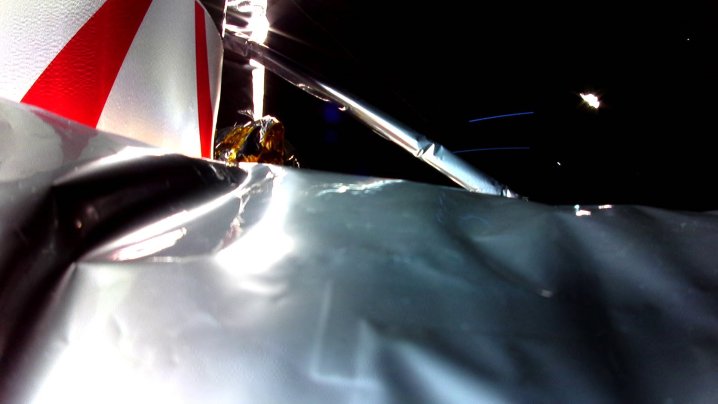
UPDATE: Astrobotic confirmed on Monday evening that the Peregrine lander will not be able to make it to the lunar surface. In a post on social media, it said that an ongoing propellant leak is causing the spacecraft’s thrusters to operate “well beyond their expected service life cycles to keep the lander from an uncontrollable tumble.” It added that based on the current rate of fuel consumption, the spacecraft’s thrusters could continue to operate for about 40 more hours, adding: “At this time, the goal is to get Peregrine as close to lunar distance as we can before it loses the ability to maintain its sun-pointing position and subsequently loses power.”
Astrobotic’s Peregrine spacecraft has beamed back its first image (above) and it provides the first visual evidence of a propulsion system anomaly.
The mission to put the first American commercial robotic lander on the moon got off to a perfect start early on Monday with a smooth launch aboard United Launch Alliance’s brand new Vulcan Centaur rocket from the Kennedy Space Center in Florida.
But hours later, Pittsburgh-based Astrobotic confirmed that a failure within the spacecraft’s propulsion system had caused “a critical loss of propellant.”
The team said that the given the situation, it was now reassessing the goals for Peregrine Mission 1, suggesting that a successful lunar landing was now highly unlikely.
The image shared by Astrobotic was captured by a camera attached to a payload deck on the spacecraft. It shows a disturbance to the Multi-Layer Insulation (MLI) in the foreground, which the company said offered “the first visual clue that aligns with our telemetry data that points to a propulsion system anomaly.”
It added that it was using the spacecraft’s existing power “to perform as many payload and spacecraft operations as possible” and promised more updates just as soon as they become available.
Update #5 for Peregrine Mission One: pic.twitter.com/94wy2J0GyA
— Astrobotic (@astrobotic) January 8, 2024
In an earlier post on social media, Astrobotic expressed gratitude “for the outpouring of support we’re receiving,” adding, “This is what makes the space industry so special, that we unite in the face of adversity. A heartfelt thank you from the entire Peregrine Mission 1 team.”
The almost certain failure of Peregrine Mission 1 is a major disappointment not only for Astrobotic, but for NASA, too. The U.S. space agency had been hoping to see Peregrine become the first privately built lander to achieve a soft landing on the moon, paving the way for further commercial missions to our nearest neighbor.
The mission, had it reached the lunar surface, would’ve conducted scientific research on the lunar environment ahead of future crewed moon missions as part of NASA’s Artemis program.
Peregrine Mission 1 was made possible by CLIPS (Commercial Lunar Payload Services), which involves NASA partnering with private firms to send science missions to the moon ahead of the first Artemis crewed landing, which is currently scheduled to take place next year.
Despite the setback, Astrobotic will continue to plan for the launch of Griffin Mission One later this year. Griffin is the largest lunar lander since the Apollo lunar module and will carry NASA’s Volatiles Investigating Polar Exploration Rover (VIPER) to the south pole of the moon. VIPER will search for the presence of water ice in the permanently shadowed regions of Mons Mouton.
Editors' Recommendations
- Odysseus lunar lander sends a ‘fitting farewell transmission’ to Earth
- Japan’s lunar lander surprises team by waking up from cold lunar night
- Check out these cool Earth images from the latest moon mission
- Peregrine spacecraft snaps stunning Earth photo just before burning up
- NASA confirms burn-up date for failed Peregrine spacecraft


